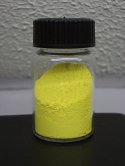|
Cadmium in artist paints - a health hazard ?
(08.02.2015)
The request to ban cadmium from artist paints is not supported by the European Chemicals Agency (ECHA)
Background: Sweden had submitted a report proposing the restriction of cadmium compounds in artist paints. The reason for the proposed action is a concern for cadmium intake via food. The safety margin between the daily intake by the general population and the health-based guidance value is too small calling for a reduction of environmental pollution. The report argues that cadmium is released to the environment from artists paints due to the cleaning procedure for the tools of artists leading to wastewater contamination. 
Cadmium sulphide
|
Cadmium zinc sulphide was introduced as "Cadmium Yellow" in 1829 and since then has been used by Gauguin, William Turner, Vincent van Gogh, Auguste Renoir, Max Slevogt and many others. Cadmium sulfoselenide has been used as "Cadmium red" since 1907. Both pigments are appreciated by artists due to their clarity and luminosity.
ECHA's opinion:
The committe for risk assessment (RAC) and the committee for socio-economic analysis (SEAC) have published their opinion on this proposed restriction. Both committees came to the conclusion that the ban request is not justified. Comments on this draft opinion can be given until February 9, 2015 (tomorrow). More than 660 comments have been submitted already, more than for any other ban requests. Most of the comments do not support the ban request. Artists argue that there are no adequate alternatives available and that the release to the environment is negligible since artists do not release their paint into wastewater.
About 120 tons of cadmium are deposited on agricultural soils in Europe each year. The main source are fertilizers with about 80 tons. About 7.4 tons can be sourced back to sewage sludge application. According to the Swedish report, 110 kg out of the 7.4 tons within the sewage sludge result from the contamination with artists paints.
Both the RAC and the SEAC argue that a ban of cadmium containing artists paint would not led to any significant reduction of the Cd exposure of the population since the reduction of Cd intake by such ban would only be about 0.006% of the total intake.
The decision by ECHA will be done in March 2015 and than reported towards the European Commision that will finally decide on the ban.
 Related information: Related information: ECHA: Restrictions under consideration: Cadmium compounds (in Artist's paints) ECHA: Restrictions under consideration: Cadmium compounds (in Artist's paints) International Cadmium Association: Cadmium pigments International Cadmium Association: Cadmium pigments Wikipedia: Cadmium pigments Wikipedia: Cadmium pigments Related EVISA Resources Related EVISA Resources Link database: Toxicity of cadmium Link database: Toxicity of cadmium Link database: Environmental cadmium pollution Link database: Environmental cadmium pollution Link database: Industrial use of cadmium Link database: Industrial use of cadmium
 Related EVISA News Related EVISA News February 4, 2013: ECHA requests comments on expanding REACH restriction on the use of cadmium in plastics February 4, 2013: ECHA requests comments on expanding REACH restriction on the use of cadmium in plastics  Februray 21, 2011: Direct speciation analysis by X-rays show why van Gogh paintings lose their shine Februray 21, 2011: Direct speciation analysis by X-rays show why van Gogh paintings lose their shine  June 22, 2010: Eight New Chemicals for REACH Candidate List of Substances of Very High Concern June 22, 2010: Eight New Chemicals for REACH Candidate List of Substances of Very High Concern October 9, 2009: REACH: Substances of very high concern October 9, 2009: REACH: Substances of very high concern  September 18, 2008: REACH Update: List of 300 chemicals of very high concern September 18, 2008: REACH Update: List of 300 chemicals of very high concern last time modified: February 8, 2015
|